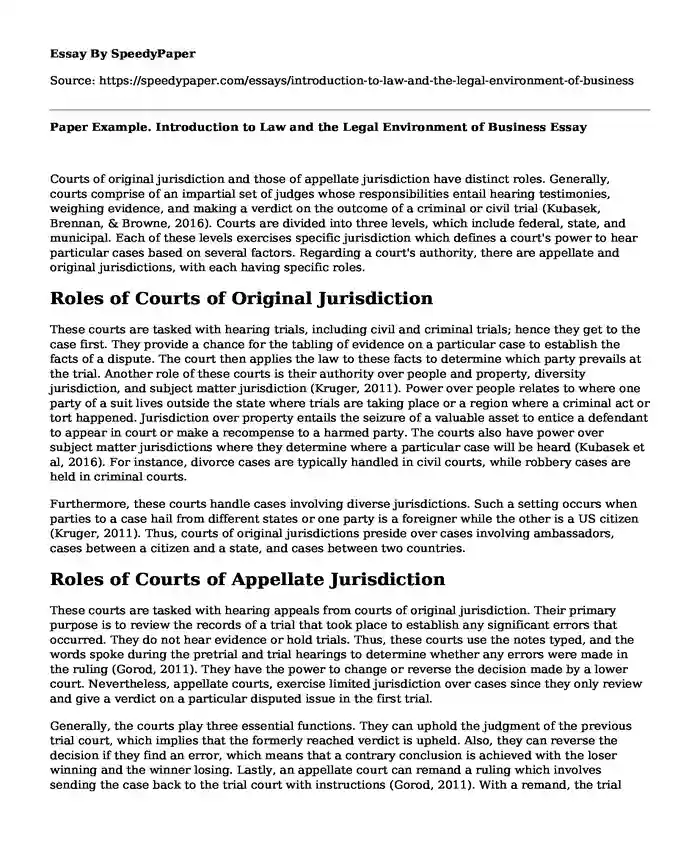
| Type of paper: | Essay |
| Categories: | Court system Judicial system Business law |
| Pages: | 3 |
| Wordcount: | 672 words |
Courts of original jurisdiction and those of appellate jurisdiction have distinct roles. Generally, courts comprise of an impartial set of judges whose responsibilities entail hearing testimonies, weighing evidence, and making a verdict on the outcome of a criminal or civil trial (Kubasek, Brennan, & Browne, 2016). Courts are divided into three levels, which include federal, state, and municipal. Each of these levels exercises specific jurisdiction which defines a court's power to hear particular cases based on several factors. Regarding a court's authority, there are appellate and original jurisdictions, with each having specific roles.
Roles of Courts of Original Jurisdiction
These courts are tasked with hearing trials, including civil and criminal trials; hence they get to the case first. They provide a chance for the tabling of evidence on a particular case to establish the facts of a dispute. The court then applies the law to these facts to determine which party prevails at the trial. Another role of these courts is their authority over people and property, diversity jurisdiction, and subject matter jurisdiction (Kruger, 2011). Power over people relates to where one party of a suit lives outside the state where trials are taking place or a region where a criminal act or tort happened. Jurisdiction over property entails the seizure of a valuable asset to entice a defendant to appear in court or make a recompense to a harmed party. The courts also have power over subject matter jurisdictions where they determine where a particular case will be heard (Kubasek et al, 2016). For instance, divorce cases are typically handled in civil courts, while robbery cases are held in criminal courts.
Furthermore, these courts handle cases involving diverse jurisdictions. Such a setting occurs when parties to a case hail from different states or one party is a foreigner while the other is a US citizen (Kruger, 2011). Thus, courts of original jurisdictions preside over cases involving ambassadors, cases between a citizen and a state, and cases between two countries.
Roles of Courts of Appellate Jurisdiction
These courts are tasked with hearing appeals from courts of original jurisdiction. Their primary purpose is to review the records of a trial that took place to establish any significant errors that occurred. They do not hear evidence or hold trials. Thus, these courts use the notes typed, and the words spoke during the pretrial and trial hearings to determine whether any errors were made in the ruling (Gorod, 2011). They have the power to change or reverse the decision made by a lower court. Nevertheless, appellate courts, exercise limited jurisdiction over cases since they only review and give a verdict on a particular disputed issue in the first trial.
Generally, the courts play three essential functions. They can uphold the judgment of the previous trial court, which implies that the formerly reached verdict is upheld. Also, they can reverse the decision if they find an error, which means that a contrary conclusion is achieved with the loser winning and the winner losing. Lastly, an appellate court can remand a ruling which involves sending the case back to the trial court with instructions (Gorod, 2011). With a remand, the trial court can take actions beyond the appellate court, such as ordering a new trial or adjusting the previous sentence. Thus, the roles of appellate courts are founded on reviewing the rationale and ruling of a lower court to take one of the three actions (Kubasek et al, 2016).
Overall, courts of original jurisdiction are lower than courts of appellate jurisdiction. The former gets the first contact with a case, and its ruling and rationale are reviewed by the latter. However, the second courts have limited powers since they can only base their judgments on the facts presented by the former courts.
References
Gorod, B. J. (2011). The Adversarial Myth: Appellate Court Extra-Record Factfinding. Duke LJ, 61, 1.
Kruger, S. (2011). Supreme Courts as Courts of General Original Jurisdiction. Int'l J. Legal Info., 39, 51.
Kubasek, N. K., Brennan, B. A., & Browne, M. N. (2016). The Legal Environment of Business: A Critical Thinking Approach. Pearson.
Cite this page
Paper Example. Introduction to Law and the Legal Environment of Business. (2023, Sep 27). Retrieved from https://speedypaper.net/essays/introduction-to-law-and-the-legal-environment-of-business
Request Removal
If you are the original author of this essay and no longer wish to have it published on the SpeedyPaper website, please click below to request its removal:
- Law Essay Sample on Grand Larceny
- Free Essay Sample: Historical Background and Purpose of Interpol
- Free Essay on the Tarasoff Case
- Essay Sample on Slavery, Dueling, and Identity
- Essay Example on Illegal Gun Holders Are a Danger to Society
- Essay Sample on Restorative Justice Discussion Board
- Report on the Conflict Between the Public and Police Following the Assassination of George Floyd - Free Essay
Popular categories




